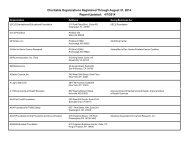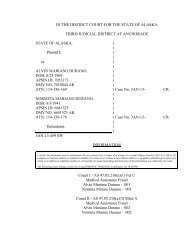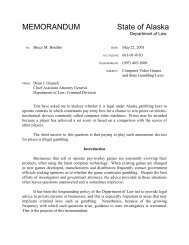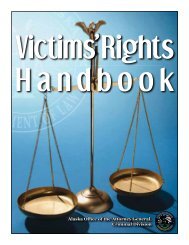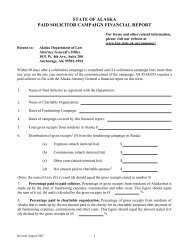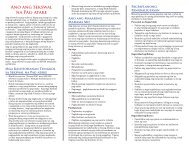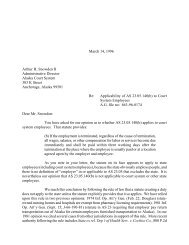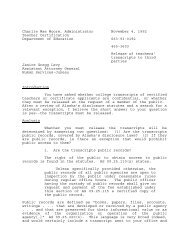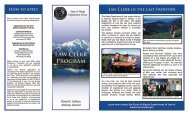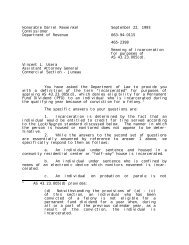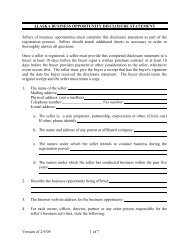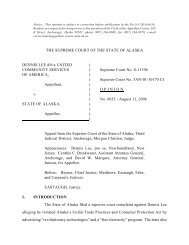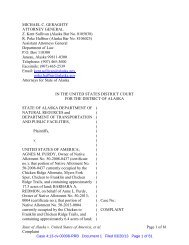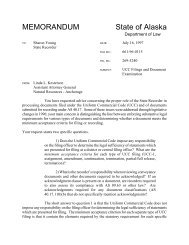Initial Report and Recommendations - Alaska Department of Law
Initial Report and Recommendations - Alaska Department of Law
Initial Report and Recommendations - Alaska Department of Law
- No tags were found...
Create successful ePaper yourself
Turn your PDF publications into a flip-book with our unique Google optimized e-Paper software.
The literature has <strong>of</strong>ten decried the problems that <strong>Alaska</strong> Natives living in ruralvillages face in trying to adjust to the modern world <strong>of</strong> “economic development” but has<strong>of</strong>fered only limited recommendations for realistic change. The issue is neither simplenor singular. There are vast differences between regions <strong>of</strong> <strong>Alaska</strong>, <strong>and</strong> any one potentialsolution, though possibly applicable to one or two villages in a certain region, will notapply to villages in other parts <strong>of</strong> the State. 27The <strong>Alaska</strong> Natives Commission published its final report in 1994, which againprovided statistics, testimony, <strong>and</strong> recommendations about the economy in rural <strong>Alaska</strong>,<strong>and</strong> 10 years after that, in 2004, the ISER released The Status <strong>of</strong> <strong>Alaska</strong> Natives <strong>Report</strong>,one section <strong>of</strong> which related to the remote rural economy. Here are highlights from theSummary <strong>of</strong> Findings from that section:• The entire remote rural region has an economy about the same size as Juneau’s.• With some notable exceptions, the billion-dollar petroleum, mining, <strong>and</strong> seafoodindustries in remote rural <strong>Alaska</strong> produce little economic benefit for localresidents. (The exceptions are the Red Dog Mine <strong>and</strong> the CommunityDevelopment Quota [CDQ] program. 28 )• Local residents get only a small share <strong>of</strong> the value <strong>of</strong> the world-class salmonfisheries in southwest <strong>Alaska</strong> – about 10 percent in 2002.• Federal money makes up the biggest share <strong>of</strong> outside money coming into remoterural areas. About $670 million came into the region in 2000.• Government <strong>and</strong> service jobs make up much bigger shares <strong>of</strong> jobs in remote ruralareas than in Anchorage – many <strong>of</strong> these are with non-pr<strong>of</strong>it Native organizationsthat now manage most health care <strong>and</strong> other federal programs for <strong>Alaska</strong> Natives.• Job growth in remote rural <strong>Alaska</strong> in the 1990s was overwhelmingly in servicejobs.• Small remote communities with low base incomes can sustain very few trade <strong>and</strong>other local support jobs that are common in urban areas – most jobs have to besustained with money from outside sources.• Unemployment is high in remote rural areas, but the published unemploymentfigures still underestimate the job shortage in remote rural areas – the figuresinclude only people actively looking for work, <strong>and</strong> local residents don’t look forwork when they know there are no jobs.• Per capita income in remote rural areas remains little more than half <strong>of</strong>Anchorage’s.2728A portion <strong>of</strong> the preceding was based on the <strong>Alaska</strong> Natives Commission Final <strong>Report</strong>, Volume II, 1994,pp. 83 <strong>and</strong> 84.For more information on the CDQ, see http://www.cdqdb.org/<strong>Alaska</strong> Rural Justice <strong>and</strong> <strong>Law</strong> Enforcement Commission - Page 21



